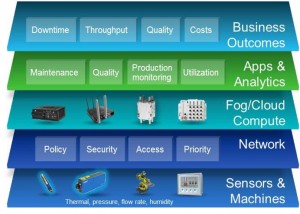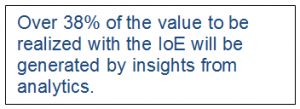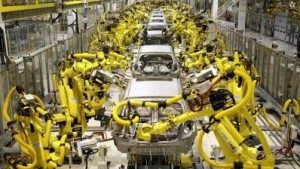I recently participated in a Cisco advisory board meeting attended by some of our leading manufacturing customers. There was a lot of discussion about the tough challenges the industry is facing. Flexibility, agility, and managing costs were hot  topics. Traditional manufacturing environments with manual processes, independent systems, and siloed data create a lack of visibility into real-time operations and result in delayed responses to quality issues and inventory waste. Many manufacturing organizations are starting to take their first steps towards becoming digital. Let’s take a look at what that means and why making the transformation to a digital factory is the next wave of evolution.
topics. Traditional manufacturing environments with manual processes, independent systems, and siloed data create a lack of visibility into real-time operations and result in delayed responses to quality issues and inventory waste. Many manufacturing organizations are starting to take their first steps towards becoming digital. Let’s take a look at what that means and why making the transformation to a digital factory is the next wave of evolution.
The Traditional Manufacturing Model
Imagine a typical engine manufacturer where temperature, metal flow rate, pressure, or humidity can affect the quality of the engines. Alarms might be generated but data isn’t saved for analysis. Inspections occur only at the end of the line and quality issues are not caught until 24-72 hours after the fact. A scenario where hundreds of defective engines are produced is very real. And the impact? As high as $250,000 per incident.
Making the Shift to a Digital Factory
The Internet of Everything makes it possible to transform traditional manufacturing into the digital factory:
- Connecting hundreds of temperature, pressure, flow rate, and humidity sensors with a converged network makes it possible to capture real-time sensor and quality data normalized in a single data stream.
- Applications analyze data at every stage of the manufacturing process resulting in real-time quality management that allows issues to be predicted followed by prescriptive alerts and notifications sent to operators.
- Continual changes to machine settings optimize quality.
Analytics: The Focus for Innovation
Once everything is connected everywhere, analytics become the focus for innovation. The digital platform we just described will enable these actionable insights and make it possible to minimize downtime,  improve throughput, limit quality issues, and manage costs. This new digital factory takes advantage of continuous real-time measurements and analysis and in-line quality inspections and instant rework to be more productive, flexible, and cost efficient.
improve throughput, limit quality issues, and manage costs. This new digital factory takes advantage of continuous real-time measurements and analysis and in-line quality inspections and instant rework to be more productive, flexible, and cost efficient.
Moving From the Traditional to the Digital and Beyond
Cisco is uniquely positioned to help customers move from traditional to digital and beyond to fully capture the value of the IoE. We help clients re-invent their businesses and see what’s possible when technology and business strategies come together seamlessly. We make digitization a reality by deploying agile infrastructures that speed innovation and by connecting the unconnected to turn data from anywhere into insights everywhere.
Cisco’s market-leading Connected Factory solution help customers harness the power of IoT to delivery real business outcomes. This portfolio of validated, proven  architectures, capabilities, technologies, and services makes it possible for customers to transform their operation into a digital factory to gain the control they need over their business.
architectures, capabilities, technologies, and services makes it possible for customers to transform their operation into a digital factory to gain the control they need over their business.
This week at Hannover Messe, the world’s leading trade fair for industrial technology, Cisco will be showcasing our Connected Factory, Connected Oil & Gas, and Connected Utilities solutions to show how we:
- Scale global experts remotely with video collaboration and real-time plant floor data analytics
- Secure plant assets, deliver machine to machine automation and improve operational workflows
- Monitor and analyze plant performance with more context, on any device, anytime, anywhere
- Secure Integration of IT and Factory Automation
Cisco is ready with the solutions that deliver the outcomes that customers need to day. Are you ready?
Very insightful and helpful blog Tony and well described. We need to identify more and more customer pain points which are present in an unconnected world and how Cisco can add a lot of value by solving these critical challenges .
It is good to hear directly from the leading manufacturing customers- describing the pain points. And this is our focus in IVSG to connect directly the technology to the business outcomes.
Another good thing to see is that we are also bringing in the nomenclature of “Digital” in our IOE world. This is the term being used widely now in the industry.
Thanks for sharing..